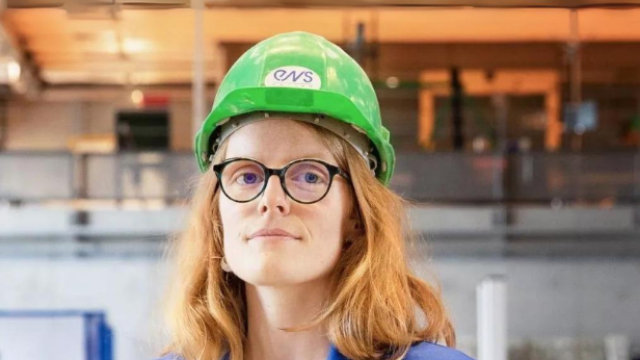Amandine Asselin (2A COMPETITION, DGCE), Winner of the Young Talents France 2023 "For Women and Science" Award
"One should not hold back and believe those who might say that a particular field is not suitable for women. As long as curiosity is present, as long as there is motivation, there will inevitably be a place for you!"
What is your academic background?
After 3 years in preparatory classes, I entered ENS through the Saphire application process. Subsequently, I chose to specialize in civil engineering. At the end of this first year, I took the second entrance exam, which I passed.
For my M1, I chose to work on materials and structures. I then went on a 10-month internship in the Structural Engineering Research Group at Polytechnique Montréal under the supervision of Jean-Philippe Charron. I discovered the experimental side of research, which I liked a lot. Finally, to complete my journey, I followed the M2 Materials and Structures in their environment at Centrale Nantes. At the end of this last year, Jean-Philippe Charron proposed a thesis, also supervised by his research associate Clélia Desmettre. Cécile Oliver-Leblond complemented this project by bringing the numerical aspect.
I benefited from a specific normalien doctoral contract (CDSN) from the School to finance my thesis at the Laboratory of Mechanics Paris-Saclay (LMPS) in collaboration with Polytechnique Montréal, under the direction of Professor Farid Benboudjema and the co-direction of Associate Professor Cécile Olivier-Leblond.
What are the axes of your research?
Making constructions more sustainable
Many French civil engineering structures are made of reinforced concrete, that is, built with concrete containing steel reinforcements. During the lifespan of the structure, cracks naturally form in the concrete due to mechanical, thermal, and hydric stresses. Now, in maritime and northern regions, salt can be found in the environment (sea salt or de-icing salt). This salt contains chlorides, highly harmful to steel, as they induce corrosion. The cracks present in the structures serve as entry points for chlorides to reach the steel reinforcements. Over the long term, structures can be significantly damaged by the penetration of chlorides into the concrete.
For example, in a parking structure at Syracuse University in New York, the corrosion of steel reinforcements caused by de-icing salts brought by cars led to the collapse of the slab.
Currently, to quantify the resistance of concrete to this issue, it is possible to measure the penetration rate of chlorides into the concrete through a parameter called the diffusion coefficient. However, the measurements are made on non-cracked, non-reinforced, and mechanically unloaded concrete, unlike what can be found in structures. The objective of my thesis was to develop an experimental device for measuring the penetration rate of chlorides into cracked and mechanically loaded reinforced concrete. From a numerical perspective, the goal was to add chloride penetration to an existing code to explore the impact of the shape of the cracks on the propagation speed.
Thus, my work has shown that cracking increases the speed of chloride propagation in concrete. The presence of mechanical loading also promotes chloride penetration into the concrete, albeit to a lesser extent. Finally, numerical simulations have demonstrated that the shape of the crack also impacts the propagation of chlorides.
Discover the details of her research (CNRS article).
What are your future professional perspectives?
For now, I don't know yet. I am focusing on completing my thesis, and I will see afterward.
Do you have anything to say to female students (or future students) at ENS Paris-Saclay?
Do not hold back and believe those who might say that a particular field is not suitable for women. As long as curiosity is present, and there is motivation, there will inevitably be a place for you!
AWARDS AND DISTINCTIONS
2023: Winner of the Young Talents France 2023 "For Women and Science" Award
First and foremost, it should be known that the award is given to 35 women, including doctoral and post-doctoral candidates, from all fields of science. For 4 days, we undergo training together on various subjects, ranging from negotiation to communication or responding to sexist violence. The training is very enriching, with high-level speakers. These few days away from the daily routine allowed me to make very beautiful connections with women who face the same difficulties as me in their journey, even if they are in totally different scientific fields. This award is a real honor for me because it is very prestigious. It rewards both my scientific work and the commitment I have had in my journey to convey my interest in science to younger generations.

Comments0
Please log in to see or add a comment
Suggested Articles


